JUKI DDL-9000C-F Instruction Manual

DDL-9000C-F
INSTRUCTION MANUAL
CONTENTS
1. SPECIFICATIONS............................................................................................................ |
1 |
|
1-1. |
Specifications of the sewing machine head...................................................................... |
1 |
1-2. |
Specifications of the control box....................................................................................... |
1 |
2. SET UP............................................................................................................................. |
2 |
|
2-1. |
Drawing of table................................................................................................................... |
2 |
2-2. |
Cautions when setting up the sewing machine................................................................ |
3 |
2-2-1. How to carry the sewing machine............................................................................................. |
3 |
|
2-2-2. Caution when placing the sewing machine............................................................................. |
3 |
|
2-3. |
Installation............................................................................................................................ |
3 |
2-4. |
Installing the thread stand.................................................................................................. |
4 |
2-5. |
Installing the electrical box................................................................................................. |
5 |
2-6. |
Connecting the power switch cable................................................................................... |
5 |
2-6-1. Installing the power switch........................................................................................................ |
5 |
|
2-6-2. Connecting the power source cord.......................................................................................... |
6 |
|
2-6-3. Installing the reactor box........................................................................................................... |
7 |
|
2-7. |
Connecting the cords.......................................................................................................... |
8 |
2-8. |
Handling the cords............................................................................................................... |
9 |
2-9. Attaching the connecting rod............................................................................................. |
9 |
|
2-10. Adjustment of the pedal.................................................................................................... |
10 |
|
2-10-1. Installing the connecting rod................................................................................................ |
10 |
|
2-10-2. Adjusting the pedal angle...................................................................................................... |
10 |
|
2-11. Pedal operation.................................................................................................................. |
10 |
|
2-12. |
Lubrication.......................................................................................................................... |
11 |
2-13. |
How to use the operation panel (Basic explanation)...................................................... |
12 |
2-13-1. Selection of the language (operation to be done at first)................................................... |
12 |
|
2-13-2. Names and functions of the panel keys............................................................................... |
14 |
|
2-13-3. Basic operation....................................................................................................................... |
15 |
|
3. PREPARATION BEFORE SEWING............................................................................... |
16 |
|
3-1. Attaching the needle.......................................................................................................... |
16 |
|
3-2. |
Removing/fitting the bobbin case.................................................................................... |
16 |
3-3. |
Winding the bobbin thread................................................................................................ |
17 |
3-4. |
Threading the machine head............................................................................................ |
19 |
3-5. |
Thread tension................................................................................................................... |
20 |
3-5-1. Adjusting the thread tension No. 1 tension........................................................................... |
20 |
|
3-5-2. Adjusting the needle thread tension (Active tension)........................................................... |
20 |
|
3-5-3. Adjusting the bobbin thread tension...................................................................................... |
20 |
|
3-6. |
Presser foot (Active presser device)................................................................................ |
21 |
3-6-1. Presser foot pressure.............................................................................................................. |
21 |
|
3-6-2. Micro-lifter function.................................................................................................................. |
21 |
|
3-6-3. Changing the initial value of presser foot pressure.............................................................. |
22 |
|
3-6-4. Manual lifter.............................................................................................................................. |
22 |
|
3-7. Adjusting the stitch length................................................................................................ |
23 |
|
3-8. |
Changing the sewing speed.............................................................................................. |
23 |
3-9. |
LED hand light.................................................................................................................... |
24 |
3-10. |
Reverse feed stitching....................................................................................................... |
24 |
3-11. Custom switch.................................................................................................................... |
25 |
|
i
3-12. Adjusting the amount of oil (oil splashes) in the hook................................................... |
26 |
3-12-1. Adjusting the amount of oil in the hook............................................................................... |
26 |
3-12-2. How to confirm the amount of oil (oil splashes)................................................................. |
27 |
3-12-3. Sample showing the appropriate amount of oil.................................................................. |
27 |
3-13. Adjusting the thread take-up spring and the thread take-up stroke............................. |
28 |
4. HOW TO USE THE OPERATION PANEL...................................................................... |
29 |
4-1. Explanation of the sewing screen (when selecting a sewing pattern).......................... |
29 |
4-2. Sewing patterns................................................................................................................. |
33 |
4-2-1. Sewing pattern configuration.................................................................................................. |
33 |
4-2-2. List of sewing patterns............................................................................................................ |
34 |
4-2-3. Reverse feed stitching (at start) pattern................................................................................. |
36 |
4-2-4. Double reverse-feed stitch...................................................................................................... |
41 |
4-2-5. Editing the sewing patterns..................................................................................................... |
42 |
4-2-6. List of pattern functions.......................................................................................................... |
44 |
4-2-7. Reverse feed stitching (at end) pattern.................................................................................. |
47 |
4-2-8. Teaching function..................................................................................................................... |
48 |
4-2-9. One-touch utility changeover function................................................................................... |
50 |
4-2-10. Registration of a new sewing pattern................................................................................... |
51 |
4-2-11. Copying a pattern................................................................................................................... |
53 |
4-2-12. Narrow-down function........................................................................................................... |
54 |
4-3. Counter function................................................................................................................ |
56 |
4-3-1. Displaying the sewing screen under the counter display mode.......................................... |
56 |
4-3-2. Types of the counter................................................................................................................ |
56 |
4-3-3. How to set the counter............................................................................................................. |
57 |
4-3-4. How to reset the count-completion state............................................................................... |
60 |
4-4. Simplified chart of panel displays.................................................................................... |
61 |
4-5. List of memory switch data............................................................................................... |
62 |
4-6. List of errors....................................................................................................................... |
67 |
4-7. Memory switch data........................................................................................................... |
71 |
5. MAIN NEW FUNCTIONS................................................................................................ |
73 |
5-1. Shorter-thread remaining thread trimming...................................................................... |
73 |
5-2. Adjusting the feed dog height........................................................................................... |
76 |
5-3. Operating timing of the feed............................................................................................. |
77 |
5-4. Changing the feed locus................................................................................................... |
78 |
6. CARE.............................................................................................................................. |
79 |
6-1. Maintenance mode............................................................................................................. |
79 |
6-2. Confirmation of the amount of oil in the hook oil tank................................................... |
79 |
6-3. Cleaning.............................................................................................................................. |
80 |
6-4. Applying grease................................................................................................................. |
80 |
6-5. Applying grease to the needle bar lower bushing and the presser bar bushing......... |
81 |
6-6. Replacing the fuse............................................................................................................. |
82 |
7. ADJUSTMENT OF THE MACHINE HEAD (APPLICATION)......................................... |
83 |
7-1. Needle-to-hook relationship.............................................................................................. |
83 |
7-2. Adjusting the needle thread presser device.................................................................... |
84 |
7-3. Adjusting the thread trimmer............................................................................................ |
87 |
7-3-1. For checking of the thread trimming cam timing.................................................................. |
87 |
7-3-2. Adjustment of the thread trimming cam timing..................................................................... |
87 |
7-3-3. Checking of the knife unit........................................................................................................ |
88 |
ii
7-3-4. Adjustment of the knife unit...................................................................................... |
89 |
7-3-5. Adjustment of thread trimming speed.................................................................................... |
90 |
7-4. Adjustment of the picker................................................................................................... |
91 |
7-4-1. Checking the standard adjustment......................................................................................... |
91 |
7-4-2. Standard adjustment................................................................................................................ |
91 |
7-4-3. Standard adjustment (Adjustment at the tip position).......................................................... |
91 |
7-5. Active-presser multi-layered section detection function............................................... |
92 |
7-5-1. Multi-layered section detection function................................................................................ |
92 |
7-5-2. Multi-layered-section detection number of stitches setting function................................. |
94 |
7-6. Grease shortage alarm...................................................................................................... |
95 |
7-6-1. Regarding the grease shortage alarm.................................................................................... |
95 |
7-6-2. E221 Grease-shortage error.................................................................................................... |
95 |
7-6-3. Regarding K118 error resetting procedure............................................................................ |
96 |
8. HOW TO USE THE OPERATION PANEL (APPLICATION).......................................... |
97 |
8-1. Management of sewing patterns...................................................................................... |
97 |
8-1-1. Creation of a new pattern........................................................................................................ |
97 |
8-1-2. Copying a pattern..................................................................................................................... |
99 |
8-1-3. Deleting a pattern................................................................................................................... |
100 |
8-2. Setting up the polygonal-shape stitching...................................................................... |
101 |
8-2-1. Editing a polygonal-shape stitching pattern........................................................................ |
101 |
8-2-2. Creating a new polygonal-shape stitching pattern............................................................. |
103 |
8-2-3. Setting the step from which polygonal-shape stitching is started.................................... |
103 |
8-3. Cycle pattern.................................................................................................................... |
104 |
8-3-1. Selecting the cycle pattern.................................................................................................... |
104 |
8-3-2. Editing cycle sewing data ..................................................................................................... |
105 |
8-3-3. Creating a new cycle pattern................................................................................................. |
106 |
8-3-4. Setting the step from which cycle sewing pattern is started............................................. |
108 |
8-4. Custom pitch.................................................................................................................... |
109 |
8-4-1. Selecting a custom pitch....................................................................................................... |
109 |
8-4-2. Creating a new custom pitch................................................................................................. |
111 |
8-4-3. Custom pitch edit function.................................................................................................... |
114 |
8-4-4. Copying/deleting a custom pitch.......................................................................................... |
115 |
8-5. Condensation custom pattern........................................................................................ |
116 |
8-5-1. Selecting the condensation custom..................................................................................... |
116 |
8-5-2. Creating a new condensation custom.................................................................................. |
116 |
8-5-3. Condensation custom edit function..................................................................................... |
119 |
8-5-4. Copying/deleting a condensation custom........................................................................... |
120 |
8-6. Simple lock of the screen................................................................................................ |
121 |
8-7. Version information......................................................................................................... |
121 |
8-8. Adjustment of brightness of the LED panel.................................................................. |
122 |
8-9. Information....................................................................................................................... |
123 |
8-9-1. Data communication.............................................................................................................. |
123 |
8-9-2. USB.......................................................................................................................................... |
126 |
8-9-3. Production management....................................................................................................... |
128 |
8-9-4. NFC.......................................................................................................................................... |
131 |
8-10. Key customization......................................................................................................... |
132 |
8-10-1. Assignable data.................................................................................................................... |
132 |
8-10-2. How to assign a function to a key....................................................................................... |
133 |
iii
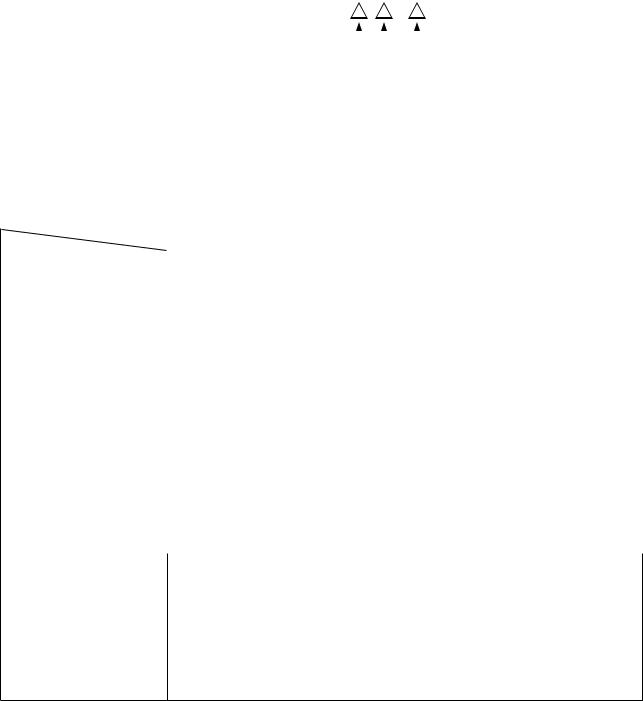
1. SPECIFICATIONS
1-1. Specifications of the sewing machine head
|
|
DDL-9000C-F |
- |
|
|
B |
|||||||
|
Face plate portion lubricating method |
|
|
|
|
|
|
|
|
|
|
||
|
M |
Semi-dry |
|
|
|
|
|
|
|
|
|
|
|
|
S |
Micro-quantity lubrication |
|
|
|
|
|
|
|
|
|
|
|
|
Seam specification |
|
|
|
|
|
|
|
|
|
|
||
|
S |
Medium-weight materials |
|
|
|
|
|
|
|
|
|
|
|
|
H |
Heavy-weight materials |
|
|
|
|
|
|
|
|
|
|
|
|
Needle thread nipper specification |
|
|
|
|
|
|
|
|
|
|
||
|
N |
With |
|
|
|
|
|
|
|
|
|
|
|
|
0 |
Without |
|
|
|
|
|
|
|
|
|
|
|
|
|
|
|
|
|
|
|
|
|
|
|
|
|
|
|
DDL-9000C-FMS |
|
|
|
|
|
|
|
|
|
DDL-9000C-FSH |
|
|
|
|
|
|
|
|
|
|
|
|
|
|
|
Max. sewing speed |
Stitch length 0 to 4.00 : 5,000 sti/min |
|
|
|
Stitch length 0 to 4.00 : 4,500 sti/min |
||||||||
(standard locus) |
Stitch length 4.05 to 5.00 : 4,000 sti/min |
|
|
Stitch length 4.05 to 5.00 : 4,000 sti/min |
|||||||||
Stitch length |
|
|
|
|
|
|
5 mm |
||||||
|
|
|
|
|
|
|
|
|
|
|
|
|
|
Presser foot pressure control |
|
|
Electronic control |
||||||||||
|
|
|
|
|
|
|
|
|
|
|
|
||
Needle *1 |
1738 Nm65 to 110 (DB×1 #9 to 18) |
|
|
1738 Nm125 to 160 (DB×1 #20 to 23) |
|||||||||
134 Nm65 to 110 (DP×5 #9 to 18) |
|
|
|
134 Nm125 to 160 (DP×5 #20 to 23) |
|||||||||
|
|
|
|
|
|||||||||
Lubricating oil |
JUKI NEW DEFRIX OIL No. 1 or JUKI CORPORATION GENUINE OIL 7 |
||||||||||||
|
|
|
|
|
|
|
|
|
|
|
|
|
|
Motor |
|
|
|
AC servo motor |
|||||||||
|
|
|
|
|
|
|
|
|
|
|
|
|
|
Horizontal feed control |
|
|
Electronic control |
||||||||||
Vertical feed control |
|
|
Electronic control |
||||||||||
|
|
|
|
|
|
|
|
|
|
|
|
|
|
|
|
Sewing pattern |
99 patterns (For the polygonal shape sewing, as |
||||||||||
|
|
|
|
many as 10 patterns can be registered.) |
|||||||||
Number of patterns |
Cycle sewing pattern |
9 patterns |
|
|
|||||||||
|
|
Custom-pitch pattern |
20 patterns |
|
|
||||||||
|
|
Condensation custom pattern |
9 patterns |
|
|
||||||||
|
|
FMS ; |
|
|
|
|
|
|
|
|
|
|
|
|
|
- Equivalent continuous emission sound pressure level (LpA) at the workstation: |
|||||||||||
|
|
A-weighted value of 81.5 dBA ; (Includes KpA = 2.5 dBA) ; according to ISO 10821- |
|||||||||||
Noise |
C.6.2 -ISO 11204 GR2 at 5,000 sti/min. |
|
|
||||||||||
FSH ; |
|
|
|
|
|
|
|
|
|
|
|||
|
|
|
|
|
|
|
|
|
|
|
|
||
-Equivalent continuous emission sound pressure level (LpA) at the workstation: A-weighted value of 77.5 dBA ; (Includes KpA = 2.5 dBA) ; according to ISO 10821- C.6.2 -ISO 11204 GR2 at 4,500 sti/min.
•The sewing speed will vary depending on the sewing conditions. The sewing speed preset at the time of shipping is 4,000 sti/min.
*1 : Needle used depends on the destination.
1-2. Specifications of the control box
Supply |
Single phase |
3-phase |
Single phase |
Single phase |
voltage |
100 to 120V |
200 to 240V |
220 to 240V |
220 to 240V CE |
Frequency |
50Hz/60Hz |
50Hz/60Hz |
50Hz/60Hz |
50Hz/60Hz |
|
|
|
|
|
Operating |
Temperature : 0 to 35˚C |
Temperature : 0 to 35˚C |
Temperature : 0 to 35˚C |
Temperature : 0 to 35˚C |
environment |
Humidity : 90% or less |
Humidity : 90% or less |
Humidity : 90% or less |
Humidity : 90% or less |
Input |
520VA |
520VA |
520VA |
350VA |
|
|
|
|
|
– 1 –
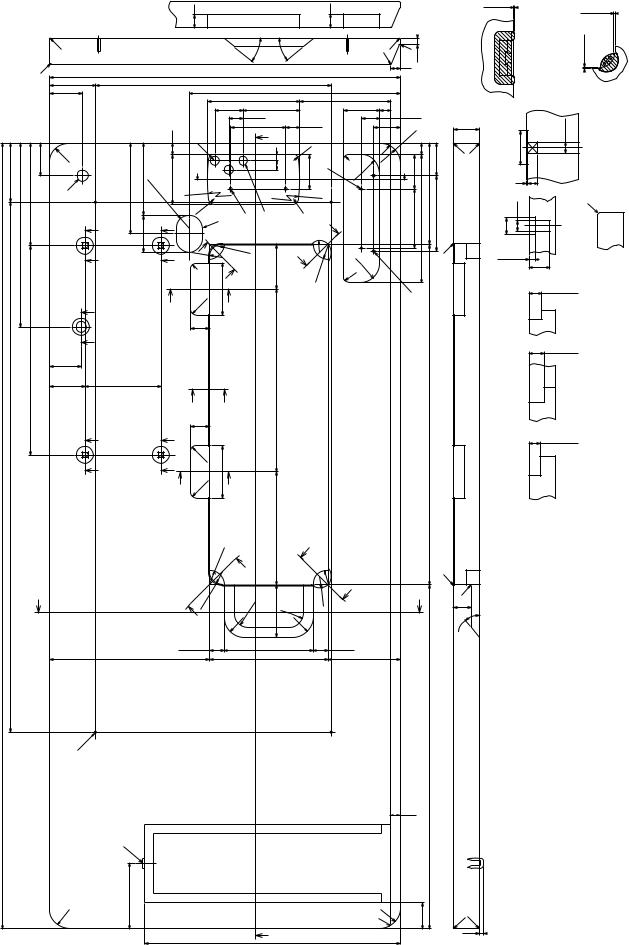
2. SET UP |
|
|
|
|
|
|
|
|
|
|
|
|
|
|
|
|
|
|
|
|
|
|
|
|
|
|
|
|
|
|
|
|||
2-1. Drawing of table |
|
|
|
|
|
|
|
|
|
|
|
|
|
|
|
|
|
|
|
|
|
|
|
|
|
|
|
|
||||||
|
|
|
|
|
|
|
|
|
+0.5 0 |
|
|
|
|
|
|
|
|
0 |
|
|
|
|
10 |
|
for |
|
|
-Y |
for |
|
|
|
||
|
|
|
|
|
|
|
|
|
|
|
|
|
|
|
|
|
|
|
|
|
|
-X drawing |
5.1±0 |
drawing |
|
|
|
|||||||
|
|
|
|
|
|
|
SS- |
|
20 |
|
|
|
|
|
|
|
|
+0.521 |
|
|
|
R2 |
|
|
|
cushion |
reference |
|
|
cushion |
|
|
|
|
|
|
|
|
|
|
|
|
|
|
|
|
|
|
|
|
|
|
|
|
|
|
|
Rubber |
|
|
Rubber reference |
5.2±0.1 |
|
||||||
|
U - U |
|
|
|
|
|
|
|
|
|
|
|
|
|
|
|
|
|
|
|
|
|
|
|
|
installing X - X |
|
|
Y |
installing Y - Y 1.2±0.5 |
|
|
||
|
|
|
R2 |
|
|
|
|
|
|
|
|
|
|
40° |
40° |
|
|
|
|
|
|
R2 |
|
|
X |
|
|
|
|
|
|
|
||
|
|
|
|
|
|
|
|
|
|
|
|
|
|
|
|
|
|
|
|
|
|
R2 |
|
|
|
|
|
|
|
|
|
|
|
|
|
|
R2 |
|
|
|
|
|
|
|
|
|
|
|
|
|
|
|
|
|
|
|
|
14 |
|
|
|
|
|
|
|
|
|
|
|
|
|
|
|
|
|
|
|
|
|
|
|
535 |
|
|
|
|
|
|
|
|
|
|
|
|
|
|
|
|
|
|
|
|
|
|
|
|
|
70 |
|
|
|
|
|
|
360 |
|
|
|
|
|
|
|
|
|
|
|
|
|
|
|
|
|
|
|
|
|
|
||
|
|
|
50 |
|
|
|
|
|
|
|
|
|
|
|
322 |
|
|
|
|
|
|
|
|
|
|
|
|
|
|
|
|
|
|
|
|
|
|
|
|
|
|
|
|
|
|
|
|
|
141 |
|
|
|
|
139 |
|
|
|
|
|
|
|
|
|
|
|
|
|
|
|
|
|
|
|
|
|
|
18 |
|
|
|
|
43 |
|
5.86 |
|
|
|
55 |
5 |
17 |
|
|
|
|
|
locations) |
|
|
8.5 |
|
|
|
||
|
|
|
|
|
|
|
|
|
|
|
|
|
W |
|
|
|
|
R8 |
|
|
|
|
|
|
|
|
|
|
|
|
||||
|
|
|
|
|
|
|
|
|
|
|
|
|
|
5.21 |
|
R8 |
|
|
|
|
|
R6 |
5.27 |
|
R2R2 |
V(1:1) |
|
|
|
|
|
|
||
|
|
|
|
|
|
|
|
|
|
|
|
|
|
84 |
5.21 |
|
|
|
40 |
R30 |
|
|
|
40 |
|
|
|
|
|
|
|
|||
|
|
|
|
|
|
|
|
|
|
|
|
|
|
|
|
|
|
|
|
|
|
|
18 |
|
|
|
V |
26 |
|
|
|
|
|
|
|
|
50 |
|
|
|
|
|
|
R8 |
|
|
|
|
|
9 |
|
F |
|
|
|
|
52.5 |
|
50 |
|
|
|
|
|
|
||||
|
|
|
|
|
|
|
|
S |
|
|
|
|
|
14 |
52 |
R27 |
|
|
|
|
|
(4 |
|
|
|
|
|
|
||||||
|
|
|
R30 |
|
|
|
|
|
|
|
|
|
|
|
|
|
|
|
|
|
|
|
|
|
|
|
|
- |
|
|
|
|
|
|
|
|
|
|
|
|
|
|
|
|
|
|
|
|
|
|
|
|
|
. |
|
|
|
|
|
|
|
|
|
|
|
|
|
||
90 281 |
156.5 |
|
C |
|
138.5 |
56 110.5 |
|
|
|
|
|
E D |
|
|
|
|
|
90 |
195 |
154.6 |
115 |
|
Q-Q 26 |
16 |
|
IT-T |
|
|
||||||
|
V |
V |
|
|
|
|
|
|
|
|
|
|
|
|
|
|||||||||||||||||||
|
|
|
|
|
|
|
75 |
|
.5 |
|
|
|
|
|
|
|
|
|
|
|
|
|
S |
|
|
|
|
|
1 |
8 |
|
|
|
|
|
|
|
|
|
|
|
2×R20 |
R242 |
|
|
|
|
|
|
R242.5 |
|
|
|
|
|
|
|
|
|
|
|
|
|
|
|
|
|||
|
|
|
|
|
|
|
|
|
|
|
|
|
|
|
|
|
|
|
|
|
|
|
|
|
|
|
|
|
|
|
|
|
||
|
|
|
|
|
|
|
|
|
R8 |
G |
|
|
|
R8 |
|
|
|
|
|
|
|
|
|
|
|
|
|
|
|
|
|
|
||
|
|
|
|
|
|
|
|
|
|
|
|
|
|
|
|
|
R18 |
|
|
|
|
|
|
|
|
|
|
|
|
|
|
|
|
|
|
|
|
|
V |
|
|
V |
|
|
|
|
|
|
|
68.5±0.5 |
|
|
|
|
|
|
|
|
|
|
C1 |
|
|
|
|
|
|
|
|
|
|
|
|
|
|
|
|
|
|
|
|
|
|
|
|
|
|
|
|
|
|
|
|
|
|
|
|
|
|
|||||
|
|
|
|
|
|
|
|
|
R20 |
|
|
5.R22 |
|
|
|
5 |
5 |
|
|
|
|
|
|
|
5±1.9 |
|
|
|
|
|
||||
|
|
|
|
|
|
|
|
|
|
|
|
|
|
|
|
|
|
|
|
|
|
|
|
|
|
|
|
|
||||||
|
|
|
|
|
|
|
|
|
|
|
|
|
|
|
|
|
|
. |
|
|
|
|
|
|
|
|
|
|
|
|
||||
|
|
|
|
|
|
|
|
|
|
|
|
|
|
|
|
|
R22 |
. |
R8 |
R27 |
|
|
|
|
|
|
|
|
32±1 |
|
|
|
||
|
|
|
|
|
|
|
|
|
R01 |
|
|
|
|
|
|
|
|
|
|
|
|
|
|
|
|
|
|
|
||||||
|
|
|
|
|
|
|
|
|
|
|
|
|
|
|
|
|
|
|
|
|
H |
|
|
|
locations)(2 |
|
|
|
|
|
|
|||
|
320 |
|
|
|
|
X |
|
R10 |
|
80 X |
|
|
|
|
|
|
|
|
|
|
|
|
|
|
|
5.5±0.19 |
|
|
|
|||||
|
|
|
|
|
|
|
|
|
|
|
|
|
|
|
|
|
|
|
|
|
|
|
|
|
|
|
|
|
|
|
|
|
|
|
|
|
|
|
|
|
|
|
|
29 |
|
|
|
|
|
|
|
|
|
|
|
|
|
|
|
|
|
|
Z-Z |
|
|
|
|
|
|
|
|
|
|
|
|
|
|
|
|
|
|
|
|
|
|
|
|
|
|
|
|
|
|
|
|
|
|
|
|
|
|
|
|
|
|
|
|
|
|
|
|
|
|
|
|
|
|
|
|
279±1 |
|
|
|
|
|
|
|
|
|
520 |
|
|
locations)(2 |
|
|
5.5±0.23 |
|
|
|
|
|
|
48 |
|
|
|
|
|
T |
|
|
T |
|
|
|
|
|
|
|
|
|
|
|
|
|
|
|
|
|
|
|
|||
|
|
|
54 |
|
116 |
|
|
|
|
|
|
|
|
|
|
|
|
|
|
|
|
|
|
|
|
|
|
Y |
|
|
|
|
|
|
|
|
|
|
|
|
|
|
|
|
|
|
|
|
|
|
|
|
|
|
|
|
|
|
|
|
Y- |
|
|
|
|
|
|
||
|
|
|
|
|
|
|
|
|
|
|
|
|
|
|
|
|
|
|
|
|
|
|
|
|
|
|
|
|
|
|
|
|
|
|
|
|
|
|
|
|
|
|
|
29 |
|
|
|
|
|
|
|
|
|
|
|
|
|
|
|
|
|
|
|
|
|
|
|
|
|
810 |
|
|
|
V |
|
|
V V X |
|
|
80 X |
|
|
|
|
|
|
|
|
|
|
|
|
|
|
|
locations)( |
|
|
|
|
|
|
||
|
|
|
V |
|
|
|
|
|
|
|
|
|
|
|
|
|
|
|
|
|
|
|
|
|
5.5±0.17 |
|
|
|
||||||
|
|
|
|
|
|
|
|
|
R10 |
|
|
|
|
|
|
|
|
|
|
|
|
|
|
|
|
|
|
|
|
|
|
|
|
|
|
|
|
|
|
|
|
|
|
R10 |
|
|
|
|
|
|
|
|
|
|
|
|
|
|
|
|
|
|
X-X |
|
|
|
|
|
|
|
|
|
|
|
|
|
|
|
|
|
|
|
|
|
|
|
|
|
|
|
|
|
|
|
|
|
(2 |
|
|
|
|
|
|
|
|
|
|
|
|
|
|
|
|
|
|
|
|
|
|
|
|
|
|
|
|
|
|
|
|
|
|
|
|
|
|
|
set-up.) |
|
|
1200 |
|
|
|
|
|
|
|
|
|
|
|
5 |
|
|
172.5 |
Y |
5 |
|
|
|
|
|
|
|
W-W |
|
set-up.) |
|
|
|
|
|||
|
|
|
|
|
|
|
|
|
|
|
R22 |
. |
|
|
|
|
. |
|
|
|
|
|
|
|
|
|
|
|
|
|
|
|
|
|
|
|
|
|
|
|
|
|
|
|
|
|
|
|
|
|
R22 |
|
|
|
|
|
|
|
|
|
of |
|
|
|
of |
|
|||
|
|
|
|
|
|
|
|
|
|
|
|
|
|
Z |
|
|
|
|
|
|
|
|
|
|
|
|
|
|
|
|
|
|||
|
|
U |
|
|
|
|
|
|
|
|
|
|
|
|
80 |
|
|
R18 |
Y |
|
|
|
|
U |
C1 |
|
time |
|
|
|
time |
|
||
|
|
|
|
|
|
|
|
R20 |
|
|
|
|
|
|
|
|
|
|
|
R2 |
|
|
|
|
|
|||||||||
|
|
|
|
|
|
|
|
|
|
|
|
|
R20 |
|
|
|
|
|
|
|
|
|
|
|
27 |
theatholea side)reverse |
|
|
theatholea |
|
||||
|
|
|
|
|
|
|
|
|
|
|
|
|
|
|
|
|
|
|
|
|
|
|
|
|
|
|
|
|||||||
|
|
|
|
|
|
|
|
|
Z |
|
|
R30 |
|
|
R20 |
|
|
|
|
|
|
|
|
|
40° |
|
|
|
||||||
|
|
|
|
|
|
|
|
|
|
|
|
|
|
|
|
|
|
|
|
|
|
|
|
|
|
|
|
|
|
|
|
|
||
|
|
|
|
|
|
|
|
|
|
|
|
|
|
|
|
R03 |
|
|
|
|
|
|
|
|
|
|
|
|
|
|
|
|
|
|
|
|
|
|
|
|
|
|
.(225) |
|
|
|
136 |
|
|
|
5.22 |
|
|
|
|
|
|
|
|
|
|
|
|
|
|
|
|||
|
|
|
|
|
(244) |
|
|
|
|
|
|
|
-1 |
|
|
|
|
110 |
|
|
|
|
|
|
|
|
|
|
|
|
|
|||
|
|
|
|
|
|
|
|
|
|
|
|
0 |
181 |
|
|
|
|
|
|
|
|
|
|
|
|
|
|
|
|
|
||||
|
|
|
|
|
|
|
|
|
|
|
|
|
|
|
|
|
|
|
|
|
|
|
|
40 525.4 |
|
|
20(Drill (on the |
|
10depth2×ø3.5, |
10(Drill |
only)side(hingeC2.5toC1.5 |
|||
|
|
|
A |
|
100 |
|
|
|
|
|
|
|
|
W |
|
|
|
|
|
|
|
|
|
|
|
surface,bottomtheon4×ø3.4depth stopperdrawerofpositionInstalling holedrilledø17 holedrilledø133× 10depth2×ø3.5, |
holeThrough surface,bottomtheon2×ø3.4depth |
|||||||
|
|
|
|
|
|
|
|
|
|
|
|
|
|
|
|
|
|
|
|
|
|
|
|
|
|
|
|
|
|
|
|
|
|
|
|
|
|
|
B |
|
|
|
|
|
|
|
|
|
|
|
|
|
|
|
|
|
|
|
|
|
|
|
|
|
|
|
|
|
|
|
|
|
R30 |
|
|
|
|
|
|
|
|
|
|
|
|
|
|
|
|
|
|
R30 |
|
|
|
R2 |
|
|
|
|
|
|
|
|
|
|
|
|
|
|
|
|
|
|
|
|
|
|
|
|
|
|
|
|
|
|
R6 |
|
|
|
R2 |
|
|
|
|
|
|
|
|
|
|
|
|
|
|
|
|
|
|
|
|
|
|
|
|
|
|
|
|
|
|
|
|
|
|
6 |
A B C D E F G H I |
|||||||
|
|
|
|
|
|
|
|
|
|
|
|
|
|
|
390 |
|
|
|
|
|
|
|
|
|
|
|
|
|||||||
|
|
|
|
|
|
|
|
|
|
|
|
|
|
|
|
– 2 – |
|
|
|
|
|
|
|
|
|
|
|
|
|
|
|
|
||
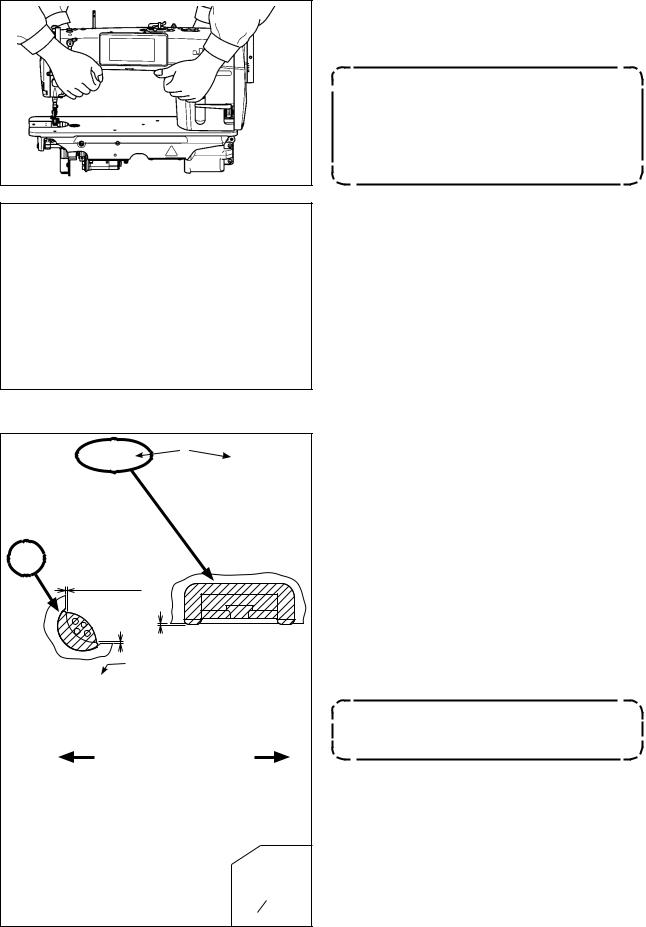
2-2. Cautions when setting up the sewing machine
Thank you very much for the purchase of JUKI Industrial Sewing Machine this time. Make sure of items 2-1 through 2-12 before operating to use this sewing machine with ease.
2-2-1. How to carry the sewing machine
Carry the sewing machine while holding the machine arm with two persons as shown in the figure.
1. Never hold the handwheel since it rotates.
2. Be sure to handle the sewing machine with two persons or more since the sewing machine weighs 40.5 kg or more.
2-2-2. Caution when placing the sewing machine
Place the sewing machine on a horizontal and plane place when placing it and do not place any protruding thing such as a screwdriver or the like.
2-3. Installation |
|
|
|
|
|
|
|
|
|
|
|
|
|
|
1.2 ± 0.5 mm |
|
|
|
1 ± 0.5 mm |
|
|
1.2 ± 0.5 mm |
|
23.5 mm |
|
19.5 mm |
|
||
|
|
|
|
|
|
|
A |
B |
|
|
|
|
|
|
|
|
|
1)The under cover should rest on the four cor-
ners of the machine table groove. Mount rubber hinge seat on the table and fix it on the table with a nail.
2)Fix two rubber seats on side A (operator’s side) using nails as illustrated above. Fix two cushion seats on side B (hinged side) using a
rubber-based adhesive. Then place under cover
on the fixed seats.
3)Fit hinge into the opening in the machine bed,
and fit the machine head to table rubber hinge seat before placing the machine head on cushions on the four corners.
Do not hold the handwheel.
– 3 –
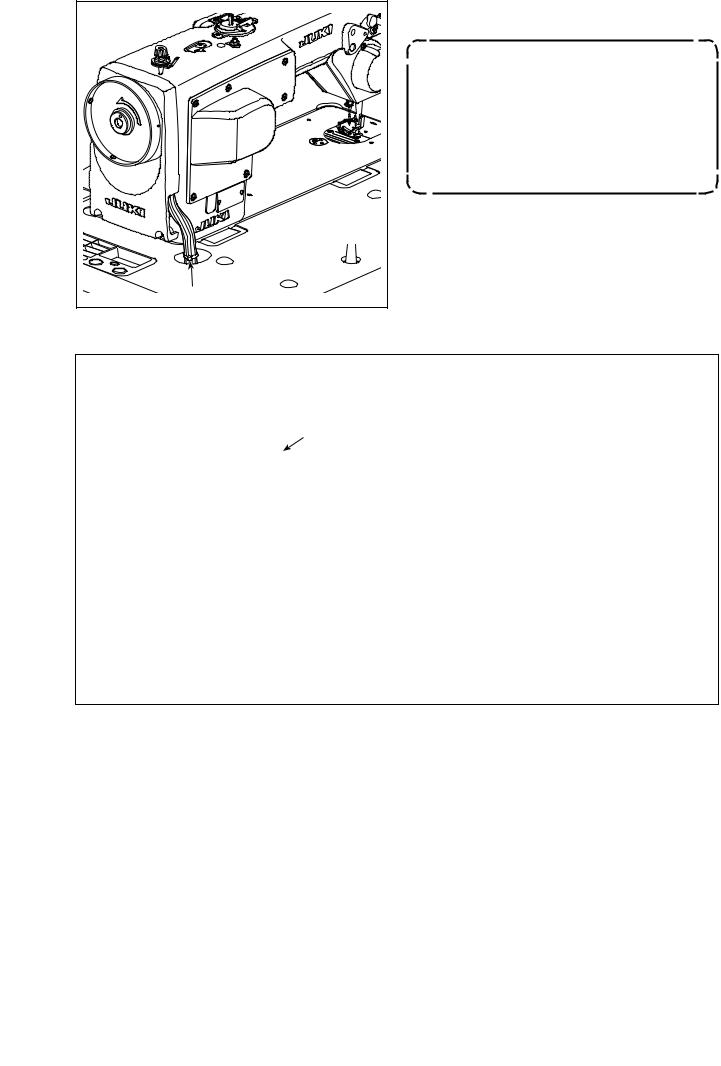
4) Securely attach head support rod to the table until it goes no further.
Be sure to mount the machine head
support rod on the machine table so
that its height from the table surface
becomes 63 to 68 mm. For the sewing
machine provided with the AK device,
be sure to mount the support rod on
the table so that its height from the table surface becomes 33 to 38 mm.
5) Bundle cable clip band supplied as accessories
of the machine head at the root of the cable.


2-4. Installing the thread stand

1)Assemble the thread stand unit, and insert it in the hole in the machine table.
2)Tighten nut .
3)For ceiling wiring, pass the power cord through spool rest rod .
– 4 –
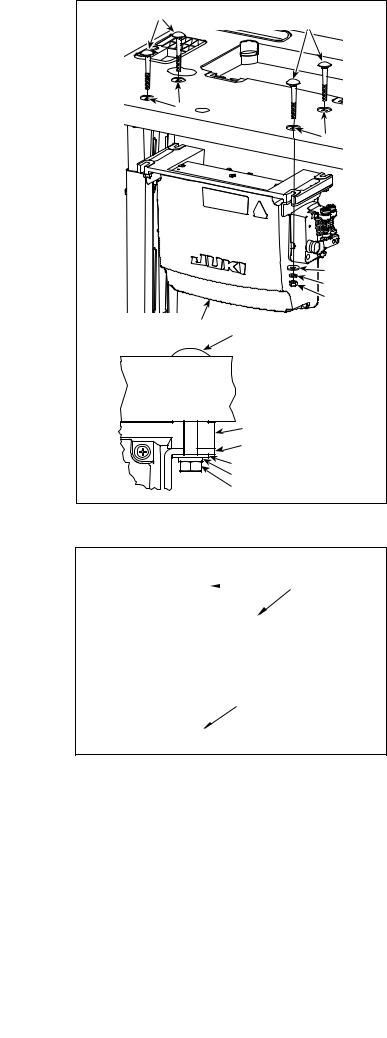
2-5. Installing the electrical box
|
|
|
|
|
|
|
a |
|
|
|
a |
|
|
|
|
|
|
|
|
|
|
|
|
|
|
|
|
|
Frame |
|
|
Pedal sensor |
|
|
|
|
|
|
|
|
|
Install control box on the table using four holes a in the table. Secure the control box with four bolts, four plain washers , four spring washers and four hexagonal nuts supplied with the control box.
At this time, insert the nut and washer supplied with the unit as accessories as shown in the figure so that the control box is securely fixed.
2-6. Connecting the power switch cable
2-6-1. Installing the power switch
Fix power switch under the machine table with wood screws .
Fix the cable with staples supplied with the machine as accessories in accordance with the forms of use.
– 5 –
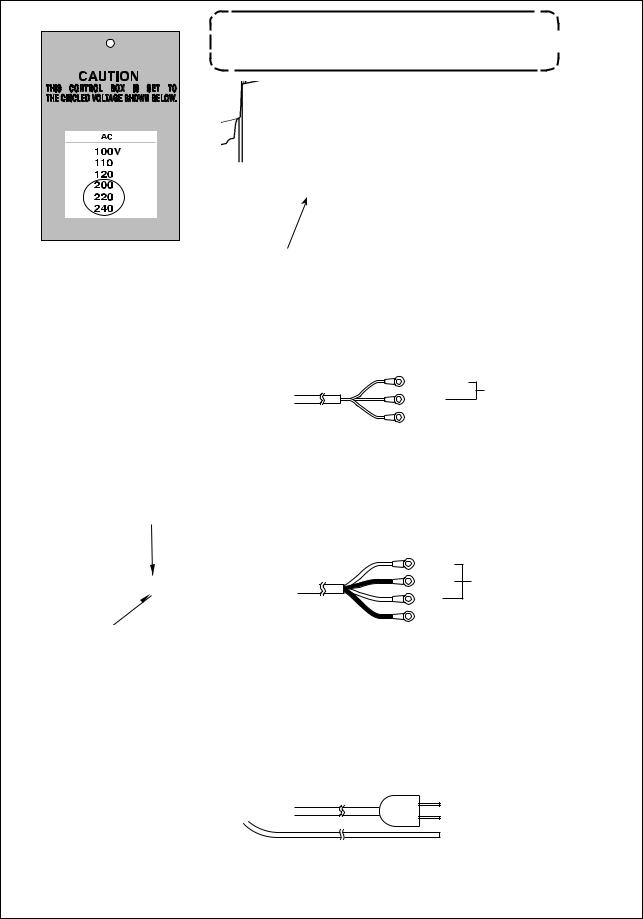
2-6-2. Connecting the power source cord
Voltage specifications at the time of delivery from the factory are indicated on the voltage indication seal. Connect the cord in accordance with the specifications.
Power indication tag
Never use under the wrong voltage and phase. 
(For example : In the case of 200V) |
Rating plate |
|
• Connecting single phase 220 to 240V
Brown |
Brown |
|
|
Table |
|
|
|
Control box |
Green/Yellow |
Light blue |
AC220 to 240V |
Green/Yellow |
|
Brown |
|
|
Green/Yellow — GND |
||
|
|
||
|
Power switch |
|
|
Light blue Light blue |
|
|
|
• Connecting 3-phase 200 to 240V
|
White |
White |
|
|
Table |
|
|
|
|
|
|
Green/Yellow |
White |
|
Control box |
|
Black |
AC200 to 240V |
|
Green/Yellow |
|
|
Red |
|
Black |
Black |
|
Green/Yellow — GND |
|
Red |
|
|
||
Red |
|
|
|
|
Power switch
• Connecting single phase 100 to 120V
Brown Brown
Table
Green/Yellow
Control box
Green/Yellow
|
|
|
Light blue |
|
Power switch |
Light blue |
||
– 6 –

2-6-3. Installing the reactor box
* For the EU-type models, install the reactor box that is supplied with the sewing machine.
|
|
|
|
|
1) Connect the terminals of power cord of the |
|
|
SC-950(951) to reactor-box PCB asm. and |
|||
|
|
|
|||
|
|
|
|
|
to reactor box mounting plate . |
|
|
|
|
A |
Connect brown wire A to the first connector |
|
|
|
|
and blue wire B to the third connector respec- |
|
|
|
|
|
|
|
|
|
|
|
C |
tively from the top of terminal block on the |
|
|
|
|
B |
reactor box PCB asm. using screws. Connect |
|
|
|
|
|
green/yellow wire C to reactor box mounting |
|
|
|
|
|
plate with earth setscrew . |
|
|
|
|
|
2) Attach cable clip to the power cord of SC- |
|
|
|
|
|
950(951). Attach the power cord together with |
|
|
|
|
|
the cable clip to reactor box mounting plate |
|
|
|
with cable clip setscrew . |
||
|
|
|
|
||
|
|
|
|
|
3) Attach cord bushes to input/output cables |
|
|
|
|
and of the reactor box. Attach both bush- |
|
|
|
|
|
|
es in the same manner. |
|
|
|
|
|
|
|
|
|
|
4) Attach reactor box cover to reactor box |
|
|
|
|
|
|
|
|
|
|
|
|
mounting plate with four reactor-box cover |
|
|
|
|
|
setscrews . |
|
|
|
|
At this time, fix cord bushes attached to |
|
|
|
|
|
|
input/output cables and in the concave |
|
|
|
|
|
section on reactor box cover to eliminate a |
|
|
|
|
gap between reactor box and cover . |
|
|
|
|
|
||
|
|
|
|
5) Install reactor box on the table stand with |
|
|
|
|
|
|
|
|
|
|
|
|
four accessory wood screws at the position |
|
|
|
|
|
that is approximately 200 mm away from the |
|
|
|
|
|
front end of table stand. |
|
|
|
|
|
Adjust the installing position according to the |
|
|
|
|
|
size of table stand so that the reactor box does |
|
|
|
|
|
not protrude from the edge of table stand. |
|
|
|
|
|
6) Fix input/output cables and of reactor |
|
|
|
|
|
box on the table stand using accessory cord |
|
|
|
|
|
staple . |
Undersurface of table |
Operator's side |
|
At this time, take care not to cross the input- |
||
|
|
|
and output-cables. |
||
|
|
|
|
|
|
|
Power box |
|
mm |
|
|
|
|
200 |
|
||
|
|
|
|
||
|
|
|
|
|
|
|
|
|
|
|
|
|
|
|
|
|
|
SC-950(951) |
|
|
|
||
|
|
|
|
|
|
|
|
|
|
– 7 – |
|

2-7. Connecting the cords
DANGER :
1.To prevent personal injuries caused by electric shock hazards or abrupt start of the sewing machine, carry out the work after turning OFF the power switch and a lapse of 5 minutes or more.
2.To prevent accidents caused by unaccustomed work or electric shock, request the electric expert or engineer of our dealers when adjusting the electrical components.
1)Loosen four setscrews of control box cover . Remove control box cover .
2)Connect the cords to the respective connectors on CTL PWB, PWR PWB. (Fig. 1)
|
|
|
|
|
Securely fix the cords to be connected |
||
|
|
|
|
|
to CN20, CN21 and CN22 with cable |
||
|
|
|
|
|
clamp . |
|
|
|
|
|
|
|
Check the connector markers of |
||
|
|
|
|
|
CN21 and CN22 to prevent improper |
||
|
|
|
|
|
connection. |
|
|
|
|
|
3) Fix the ground wire on position A of the control |
||||
|
|
box with a screw. (Fig. 2) |
|||||
|
|
|
|
|
|
||
|
|
|
|
9P |
White |
|
|
|
|
|
CN30 |
|
|
||
|
|
|
CN32 |
40P |
Gray |
|
|
|
|
CTL PWB |
CN36 |
4P |
White |
|
|
|
|
CN37 |
4P |
White |
|
|
|
|
|
|
CN38 |
15P |
White |
|
|
|
|
|
CN63 |
2P |
Black |
|
|
|
|
|
|
|
|||
|
|
|
CN20 |
4P |
White |
|
|
|
|
PWR PWB |
CN21 |
6P |
White |
|
|
|
|
|
CN22 |
6P |
White |
|
|
|
|
|
|
|
|
|
|
|
|
CN37 |
CN30 |
CN38 |
CN63 |
||

A
Fig. 2
CN32
CN21 |
CN22 |
CN20 |
CN36 |
Fig. 1
– 8 –
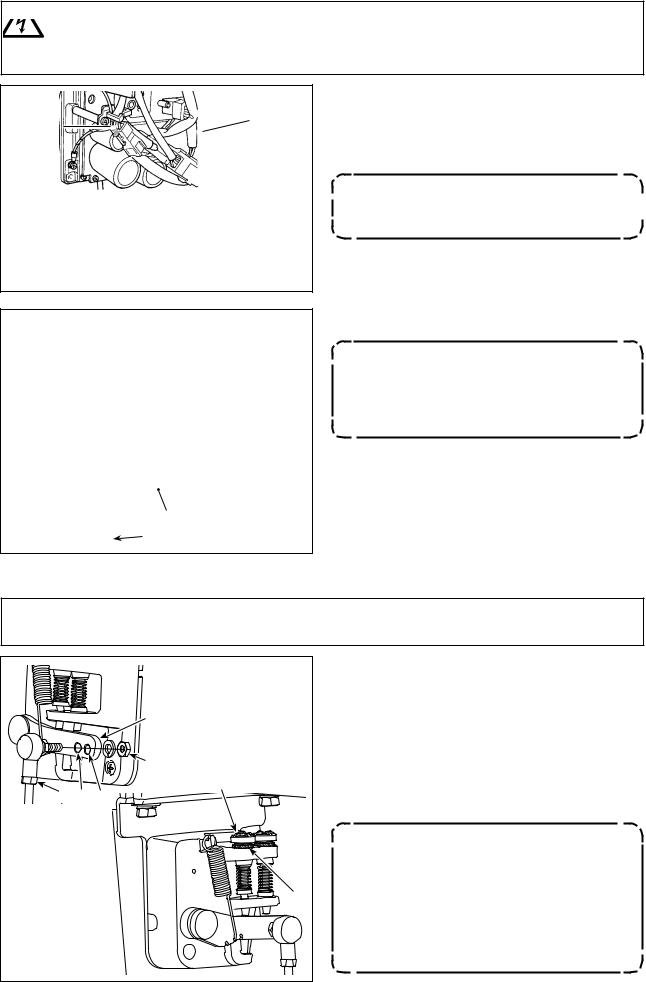
2-8. Handling the cords
DANGER :
1.To prevent personal injuries caused by electric shock hazards or abrupt start of the sewing machine, carry out the work after turning OFF the power switch and a lapse of 5 minutes or more.
2.To prevent accidents caused by unaccustomed work or electric shock, request the electric expert or engineer of our dealers when adjusting the electrical components.
1)Bring the cords under the table into the control box.

 2) Put the cord brought into the control box through
2) Put the cord brought into the control box through
cord exit plate and fix cable clip band .
Arrange the cord so that it is not tensed or hitched even when the machine head  is tilted. (See A section.)
is tilted. (See A section.)
A
3) Install control box cover with four setscrews .
For the purpose of preventing the cord breakage, take care not to allow the cords to be caught between the control box and control box cover when attaching the latter.
2-9. Attaching the connecting rod
WARNING :
To protect against possible personal injury due to abrupt start of the machine, be sure to start the following work after turning the power off and a lapse of 5 minutes or more.
|
|
|
|
B A |
|
|
|
|
|
1)Fix connecting rod to installing hole B of pedal lever with nut .
2)Installing connecting rod to installing hole A will lengthen the pedal depressing stroke, and the pedal operation at a medium speed will be easier.
3)The pressure increases as you turn reverse depressing regulator screw in, and decreases as you turn the screw out.
1.If the screw is excessively loosened, the spring will come off. Loosen the screw to such an extent that the top of the screw can be observed from the case.
2.Whenever you have adjusted the
screw, be sure to secure the screw by tightening metal nut to prevent the screw from loosening.
– 9 –

2-10. Adjustment of the pedal
WARNING :
Turn OFF the power before starting the work so as to prevent accidents caused by abrupt start of the sewing machine.
|
|
2-10-1. Installing the connecting rod |
|
|
|
1) |
Move pedal to the right or left as illustrated by the |
|
|
|
arrows so that motor control lever and connecting rod |
|
|
|
are straightened. |
|
|
2-10-2. Adjusting the pedal angle |
|
|
|||
|
|
1) |
The pedal tilt can be freely adjusted by changing the |
|
|
length of the connecting rod . |
|
|
|
|
|
|
|
2) |
Loosen adjust screw , and adjust the length of connect- |
|
|
|
ing rod . |

2-11. Pedal operation
A
B
C
D
E
The pedal is operated in the following four steps :
1)The machine runs at low sewing speed when you lightly depress the front part of the pedal. B
2)The machine runs at high sewing speed when you further depress the front part of the pedal. A (If the automatic reverse feed stitching has been preset, the machine runs at high speed after it completes reverse feed stitching.)
3)The machine stops (with its needle up or down) when you reset the pedal to its original position. C
4)The machine trims threads when you fully depress the back part of the pedal. E
*When the auto-lifer (AK device) is used, one more operating switch is provided between the sewing machine stop switch and thread trimming switch.
The presser foot goes up when you lightly depress the back part of the pedal D, and if you further depress the back part, the thread trimmer is actuated.
When starting sewing from the state that the presser foot has been lifted with the Auto-lifter and you depress the back part of the pedal, the presser foot only comes down.
•If you reset the pedal to its neutral position during the automatic reverse feed stitching at seam start, the machine stops after it completes the reverse feed stitching.
•The machine will perform normal thread trimming even if you depress the back part of the pedal immediately following high or low speed sewing.
•The machine will completely perform thread trimming even if you reset the pedal to its neutral position immediately after the machine started thread trimming action.
– 10 –

2-12. Lubrication
WARNING :
1.Do not connect the power plug until the lubrication has been completed so as to prevent accidents due to abrupt start of the sewing machine,
2.To prevent the occurrence of an inflammation or rash, immediately wash the related portions if oil adheres to your eyes or other parts of your body.
3.If oil is mistakenly swallowed, diarrhea or vomitting may occur. Put oil in a place where children cannot reach.
|
|
Fill the oil tank with oil for hook lubrication before |
|
|
|
operating the sewing machine. |
|
|
|
1) Remove oil hole cap and fill the oil tank with |
|
|
|
JUKI NEW DEFRIX OIL No.1 (part number : MD- |
|
|
|
FRX1600C0) or JUKI CORPORATION GENUINE |
|
|
|
OIL 7 (part number : 40102087) using the oiler |
|
|
|
supplied with the machine. |
|
|
|
2) Fill the oil tank with the oil until the top end of |
|
|
A |
oil amount indicating rod comes between the |
|
|
upper engraved marker line A and the lower |
||
|
|||
|
engraved marker line B of oil amount indicating |
||
|
|
||
|
B |
window . |
|
|
If the oil is filled excessively, it will leak from the |
||
|
|
||
|
|
air vent hole in the oil tank or proper lubrication |
|
|
|
will be not performed. In addition, when the oil is |
|
|
|
vigorously filled, it may overflow from the oil hole. |
|
|
|
So, be careful. |
|
|
|
3) When you operate the sewing machine, refill oil if |
|
|
|
the top end of oil amount indicating rod comes |
|
|
|
down to the lower engraved marker line B of oil |
|
|
|
amount indicating window . |
1.When you use a new sewing machine or a sewing machine after an extended period of disuse, use the sewing machine after performing break-in at 2,000 sti/min or less.
2.For the oil for hook lubrication, purchase JUKI NEW DEFRIX OIL No. 1 (part number : MDFRX1600C0) or JUKI CORPORATION GENUINE OIL 7 (part number : 40102087).
3.Be sure to lubricate clean oil.
4.Do not operate the machine with the oil hole cap removed. Never remove cap from the oil inlet in any case other than oiling. In addition, take care not to lose it.
– 11 –
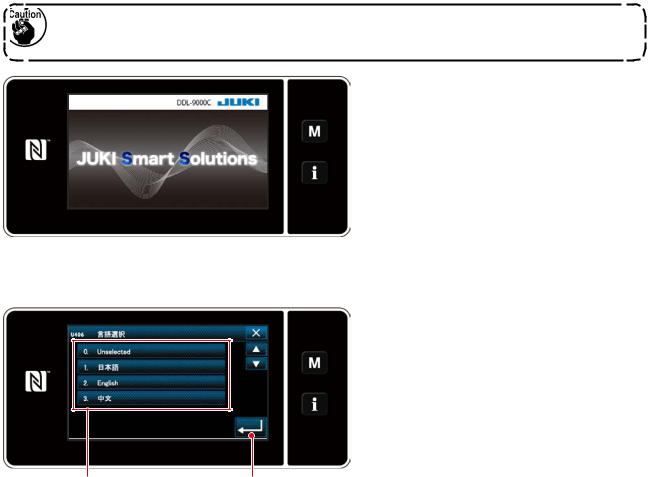
2-13. How to use the operation panel (Basic explanation)
2-13-1. Selection of the language (operation to be done at first)
Select the language to be displayed on the operation panel when you turn ON the power to your sewing machine for the first time after the purchase. Note that, if you turn the power OFF without selecting the language, the language selection screen will be displayed every time you turn ON the power to the sewing machine.
Turning ON the power switch
Be aware that the needle bar moves automatically. The needle bar can also be set so that it does not move automatically. Refer to "4-5. List of memory switch data" p. 62 for details.
Firstly, the welcome screen is displayed on the panel. Then, the language selection screen is displayed.
<Welcome screen>
Selecting the language
Select the language you want to use and press corresponding language button .
Then, press  .
.
This determines the language to be displayed on the panel.
|
|
<Language selection screen>
The language to be displayed on the operation panel can be changed using the memory switch U406. Refer to "4-5. List of memory switch data" p. 62 for details.
– 12 –
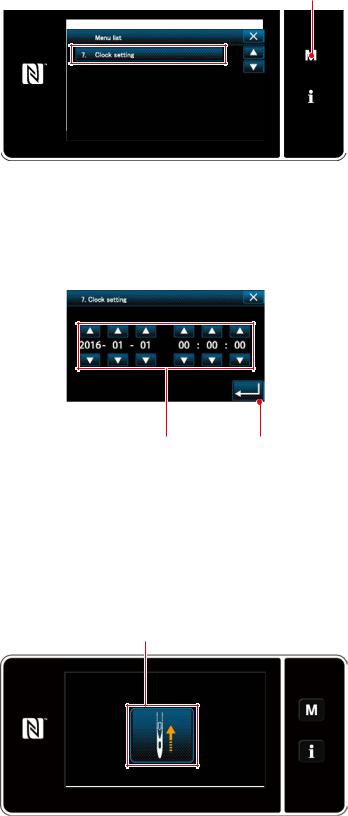
Setting the clock
1. Press  .
.
The "mode screen" is displayed. 2. Select the "7. Clock setting".
The "clock setting screen" is displayed.
<Mode screen>
<Clock setting screen>
Retrieval of the origin
<Origin retrieval screen>
3.Enter year/month/day/hour/minute/sec-
ond with  .
.
The time entered is displayed in 24-hour notation.
4.Press  to confirm the clock setting. Then, the current screen returns to the previous screen.
to confirm the clock setting. Then, the current screen returns to the previous screen.
Press to bring the origin retrieval needle bar to its upper position.
*In the case "U090 Initial operation upper position stop function" is set to "1", the screen shown on the left is not displayed, but the needle bar automatically goes up to its upper position.
– 13 –
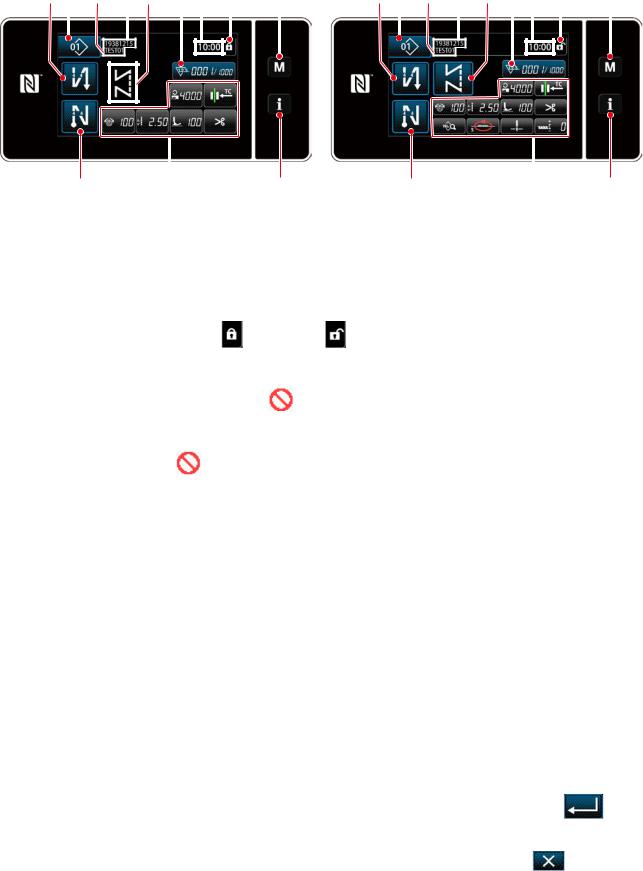
2-13-2. Names and functions of the panel keys
*Changeover between the operator mode and the maintenance personnel mode is carried out by pressing  and
and  simultaneously.
simultaneously.
|
|
<Operator mode> |
<Maintenance personnel mode> |
|||||||||||||||||||||||||
|
|
|||||||||||||||||||||||||||
|
|
|
|
|
|
|
|
|
|
|
|
|
|
|
|
|
|
|
|
|
|
|
|
|
|
|
|
|
|
|
|
|
|
|
|
|
|
|
|
|
|
|
|
|
|
|
|
|
|
|
|
|
|
|
|
|
|
|
|
|
|
|
|
|
|
|
|
|
|
|
|
|
|
|
|
|
|
|
|
|
|
|
|
|
|
|
|
|
|
|
|
|
|
|
|
|
|
|
|
|
|
|
|
|
|
|
|
|
|
|
|
|
|
|
|
|
|
|
|
|
|
|
|
|
|
|
|
|
|
|
|
|
|
|
|
|
|
|
|
|
|
|
|
|
|
|
|
|
|
|
|
|
|
|
|
|
|
|
|
|
|
|
|
|
|
|
|
|
|
|
|
|
|
|
|
|
|
|
|
|
|
|
|
|
|
|
|
|
|
|
|
|
|
|
|
|
|
|
|
|
|
|
|
|
|
|
|
|
|
|
|
|
|
|
|
|
|
|
|
|
|
|
|
|
|
|
|
|
|
|
|
|
|
|
|
|
|
|
|
|
|
|
|
|
|
|
|||||||
|
|
|
|
|
|
|
|
|
|
|
|
Switch/display |
|
|
|
|
|
Description |
|
|
|
|
|
|
|
|
|
|
|
|
||
|
Mode key |
|
|
|
This switch is used for displaying the menu screen. |
|
|
|
||
|
|
|
|
|
|
|
|
|
||
|
Information key |
|
|
|
This switch is used for displaying the information screen. |
|
|
|
||
|
|
|
|
|
|
|
||||
|
Sewing pattern No. button |
|
This switch is used for displaying the number of the sewing pattern. |
|
||||||
|
|
|
|
|
|
|
|
|||
|
Simplified screen lock |
|
|
|
This button is used for displaying the simplified lock status of the screen on it. |
|
||||
|
button |
|
|
|
Locked: |
Unlocked: |
|
|
|
|
|
|
|
|
|
|
|
|
|||
|
|
|
|
|
|
|
||||
|
Sewing-start re- |
|
|
|
This switch is used for changing the ON/OFF status of the reverse feed stitching at the |
|||||
|
verse-feed stitch button |
|
|
|
beginning of sewing. When reverse feed stitching at the beginning of sewing is placed |
|||||
|
|
|
|
|
in the OFF state, |
|
mark is displayed at the upper left of the button. |
|
||
|
|
|
|
|
|
|
||||
|
Sewing-end re- |
|
|
|
This switch is used for changing the ON/OFF status of reverse feed stitching at the end |
|||||
|
verse-feed stitch button |
|
|
|
of sewing. When reverse feed stitching at the end of sewing is placed in the OFF state, |
|||||
|
|
|
|
|
mark is displayed at the upper left of the button. |
|
|
|
||
|
|
|
|
|
|
|
||||
|
Part number |
|
|
|
In the case the part number/process display is selected with U404, the part number is |
|||||
|
|
|
|
|
displayed. In the case the comment display is selected, the comment is displayed. |
|||||
|
|
|
|
|
|
|
||||
|
Process/comment |
|
|
|
In the case the part number/process display is selected with U404, the process is dis- |
|||||
|
|
|
|
|
played. In the case the comment display is selected, the comment is displayed. |
|
||||
|
|
|
|
|
|
|
|
|||
|
Clock display |
|
|
|
The time set on the sewing machine is displayed in this field in 24-hour system. |
|
||||
|
|
|
|
|
|
|
|
|
||
|
Sewing pattern display |
|
|
|
The selected sewing pattern is displayed in this field. |
|
|
|
||
|
|
|
|
|
|
|
||||
|
Customization button 1 |
|
|
|
A selected function can be allocated to and registered with this button. Initially, the |
|||||
|
|
|
|
|
sewing counter has been factory-allocate and -registered. |
|
|
|
||
|
|
|
|
|
|
|
||||
|
Customization buttons 2 |
|
A selected function can be allocated to and registered with this button. |
|
||||||
|
- 7 |
|
|
|
|
|
|
|
|
|
|
|
|
|
|
|
|
||||
|
Customization buttons 2 |
|
A selected function can be allocated to and registered with this button. |
|
||||||
|
- 11 |
|
|
|
|
|
|
|
|
|
|
|
|
|
|
|
|
|
|
|
|
* Confirmation of data
To change the pattern number, press Sewing pattern No. button .
Select the sewing pattern you want to use. Then, press  to confirm your choice.
to confirm your choice.
For the setting items of the Memory switch or sewing pattern, change the target data and press to confirm the change.
After the setting data on the number of stitches of reverse-feed stitching or the number of stitches of
multi-layer stitching has been changed, the changed setting data is confirmed by pressing |
. |
– 14 – |
|
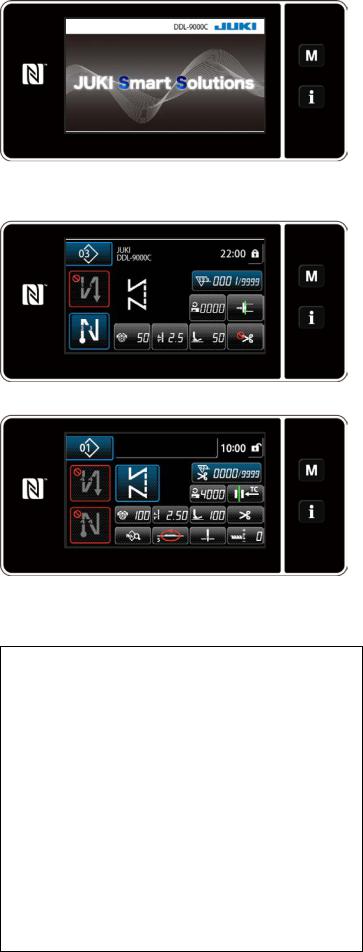
2-13-3. Basic operation
Turning ON the power switch
When you turn ON the power switch, the welcome screen is displayed.
Selecting a sewing pattern
The sewing screen is displayed.Select a sewing pattern.
Refer to "4-2. Sewing patterns" p. 33 for details.
Configure settings of each function which is assigned according to "8-10. Key customization" p. 132.
Set up functions for the selected sewing
<Sewing screen (Operator mode)> pattern.
Refer to "4-2-5. Editing the sewing patterns" p. 42 and "4-2-6. List of pattern functions" p. 44 for details.
<Sewing screen (Maintenance personnel mode)>
Starting sewing
When you depress the pedal, the sewing machine starts sewing.
Refer to "2-11. Pedal operation" p. 10.
– 15 –

3. PREPARATION BEFORE SEWING
3-1. Attaching the needle
WARNING :
Turn OFF the power before starting the work so as to prevent accidents caused by abrupt start of the sewing machine.
|
|
D |
B |
|
|
C |
A |
|
|
Use the specified needle for the machine. Use the proper needle in accordance with the thickness of thread used and the kinds of the materials.
1)Turn the handwheel until the needle bar reaches the highest point of its stroke.
2)Loosen screw , and hold needle with its indented part A facing exactly to the right in direction B.
3)Insert the needle fully into the hole in the needle bar in the direction of the arrow until the end of hole is reached.
4)Securely tighten screw .
5)Check that long groove C of the needle is facing exactly to the left in direction D.
When polyester filament thread is used, if the indented part of the needle is tilted toward operator's side, the loop of thread becomes unstable. As a result, hangnail of thread or thread breakage may occur. For the thread that such phenomenon is likely to occur, it is effective to attach the needle with its indented part slightly slanting on the rear side.
3-2. Removing/fitting the bobbin case
WARNING :
Turn OFF the power before starting the work so as to prevent accidents caused by abrupt start of the sewing machine.
|
|
1) |
Turn the handwheel to lift the needle above the |
|
|
|
|
throat plate. |
|
|
2) |
Install the bobbin in the bobbin case so that the |
||
|
|
|
thread wound direction is clockwise. |
|
|
3) |
Pass the thread through thread slit A of the bob- |
||
|
A |
bin case, and pull the thread in direction C. By |
||
|
|
|
so doing, the thread will pass under the tension |
|
|
|
|
spring and come out from notch B. |
|
|
4) |
Check that the bobbin rotates in the direction of |
||
B |
|
|
the arrow when thread is pulled. |
|
5) |
Pinching latch D of the bobbin case with fingers, |
|||
|
||||
|
|
|
fit the bobbin case in the hook. |
|
C |
|
|
|
|
D
– 16 –

3-3. Winding the bobbin thread
|
|
|
|
A |
|
|
|
|
D |
|
|
|
|
|
|
B |
|
|
C |
|
|
|
|
|
|
|
|
E |
|
|
|
|
|
|
|
|
F |
|
|
|
|
|
|
|
1)Insert the bobbin deep into the bobbin winder spindle until it will go no further.
2)Pass the bobbin thread pulled out from the spool rested on the right side of the thread stand following the order as shown in the figure on the left. Then, wind clockwise the end of the bobbin thread on the bobbin several times. (In case of the aluminum bobbin, after winding clockwise the end of the bobbin thread, wind counterclockwise the thread coming from the bobbin thread tension several times to wind the bobbin thread with ease.)
3)Press the bobbin winding lever in the direction of A and start the sewing machine. The bobbin rotates in the direction of B and the bobbin thread is wound up. The bobbin winder spindle automatically as soon as the winding is finished.
4)Remove the bobbin and cut the bobbin thread with the thread cut retainer .
5)When adjusting the winding amount of the bobbin thread, loosen setscrew and move bobbin winding lever to the direction of C or D. Then tighten setscrew .
To the direction of C : Decrease To the direction of D : Increase
6)In case that the bobbin thread is not wound evenly on the bobbin, remove the handwheel, loosen screw and adjust the height of bobbin thread tension .
•It is the standard that the center of the bobbin is as high as the center of thread tension disk .
•Adjust the position of thread tension disk to the direction of E when the winding amount of the bobbin thread on the lower part of the bobbin is excessive and to the direction F when the winding amount of the bobbin thread on the upper part of the bobbin is excessive.
After the adjustment, tighten screw .
7)To adjust the tension of the bobbin winder, turn the thread tension nut .
1.When winding the bobbin thread, start the winding in the state that the thread between the bobbin and thread tension disk is tense.
2.When winding the bobbin thread in the state that sewing is not performed, remove the needle thread from the thread path of thread take-up and remove the bobbin from the hook.
3.There is the possibility that the thread pulled out from the thread stand is loosened due to the influence (direction) of the wind and may be entangled in the handwheel. Be careful of the direction of the wind.
– 17 –
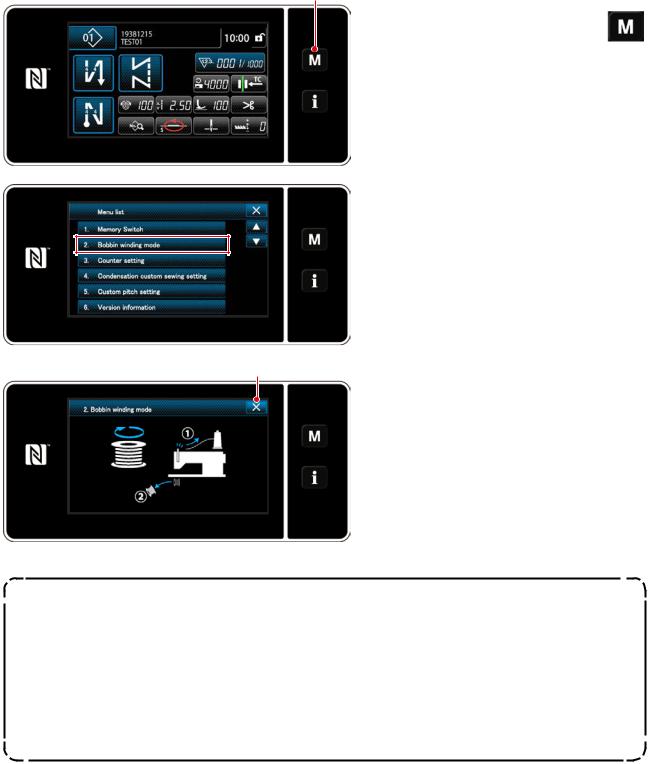
[Bobbin winding mode]
To wind a bobbin only or to check the oil quantity in the hook, the bobbin winding mode should be used. Depress the pedal to start winding a bobbin.
1) Display the mode screen by pressing
.
2) Select the "2. Bobbin winding mode".
3) The sewing machine mode is changed over to the "Bobbin winding mode".
The sewing machine runs with its presser foot up when the pedal is depressed. In this state, a bobbin can be wound. The sewing machine runs only as long as the pedal is depressed.
When  is pressed, the sewing machine exits from the "Bobbin winding mode".
is pressed, the sewing machine exits from the "Bobbin winding mode".
1.When winding the bobbin thread, start the winding in the state that the thread between the bobbin and thread tension disk is tense.
2.Remove the needle thread from the thread path of thread take-up and remove the bobbin from the hook.
3.There is the possibility that the thread pulled out from the thread stand is loosened due to the influence (direction) of the wind and may be entangled in the handwheel. Be careful of the direction of the wind.
4.The speed of the sewing machine under the bobbin winding mode is equal to the one which has been set for the machine head.
– 18 –
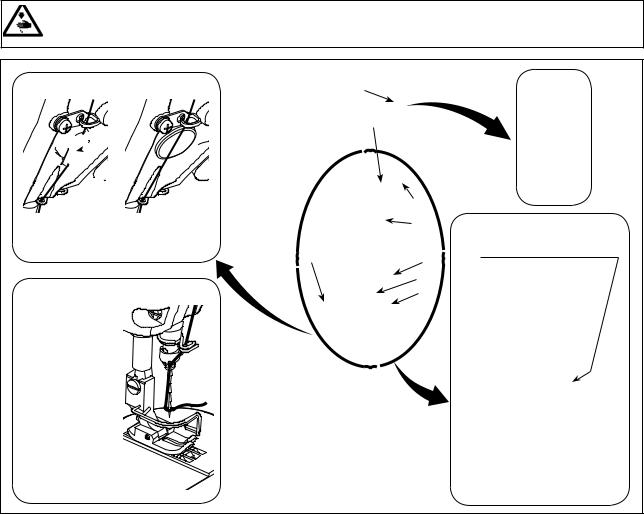
3-4. Threading the machine head
WARNING :
Turn OFF the power before starting the work so as to prevent accidents caused by abrupt start of the sewing machine.
"NB type" |
"0B type" |

 B
B
(Note)
Be sure to pass the thread through the section B.
"S type" |
"H type" |






(Note)
Do not pass this thread through section A.
A
– 19 –

3-5. Thread tension
B  A
A
C |
D |
3-5-1. Adjusting the thread tension No. 1 tension
1)Turn thread tension No. 1 nut clockwise (in direction A), to shorten the thread length
remaining on the needle after thread trimming or counterclockwise (in direction B), to lengthen the thread length.
3-5-2. Adjusting the needle thread tension (Active tension)
Active tension permits setting of the needle thread tension on the operation panel according to each sewing condition. In addition, the data can be stored in memory.
1)Press  to display the needle thread tension input screen. (The numeric value displayed on the screen is the current needle thread tension value.)
to display the needle thread tension input screen. (The numeric value displayed on the screen is the current needle thread tension value.)
2)Change the needle thread tension as desired by pressing .
3)There is a setting range of 0 to 200. When the set value is increased, the tension becomes higher.
*When the set value is 60 at the time of standard delivery, the thread tension is adjusted to 0.59 N (spun thread #60). (Reference)
(When thread tension No. 1 is released.)
3-5-3. Adjusting the bobbin thread tension
1)Turn tension adjusting screw clockwise (in direction C) to increase or counterclockwise (in direction D) to reduce the bobbin thread tension.
– 20 –

3-6. Presser foot (Active presser device)
WARNING :
Do not place anything under the presser foot when turning the power ON. If the power is turned ON while placing something under the presser foot, the sewing machine displays E910.
If the power to the sewing machine is turned ON while the material, etc. is placed under the presser foot, the presser stepping motor will generate a specific sound during origin retrieval. It should be noted that this phenomenon is not a fault.
A
|
|
|
|
|
|
|
|
|
|
|
|
|
|
|
|
|
|
|
|
|
|
|
|
|
|
|
|
|
|
||
|
|
|
|
||||
Input value on |
|
Presser foot pressure (Reference) |
|||||
the panel |
|
S type |
H type |
||||
0 |
|
|
Approx. 10 N (1 kg) |
Approx. 30 N (3 kg) |
|||
100 |
|
|
|
|
|
|
|
(Factory-set- |
Approx. 40 N (4 kg) |
Approx. 60 N (6 kg) |
|||||
ting at the time |
|||||||
of shipment) |
|
|
|
|
|
||
3-6-1. Presser foot pressure
The presser foot pressure is displayed in section A on the panel. (Example of display : 100)
[How to change]
1)Display the presser foot pressure entry screen by pressing  .
.
2)Change the presser foot pressure as desired by pressing . (Range of input values on the panel is from -350 to 200.)
*Refer to the following for a rough indication of the input value on the panel and the presser foot pressure.
3)Confirm your entry by pressing  . Then, the sewing screen is displayed.
. Then, the sewing screen is displayed.
1.To avoid personal injury, never put your fingers under the presser foot.
2.Be aware that the presser foot pressure varies when the presser foot or the throat plate is changed.
3-6-2. Micro-lifter function
Sewing while lifting the presser foot by very small amount is enabled by inputting a negative value on the panel. The micro-lifter function helps reduce slippage and damage of the material in the case of sewing raised fabric such as velvet.
*Refer to the table shown below for a rough indication of the relation among the value input on the panel, the presser foot height and the presser foot pressure.
Input value on the panel |
Presser foot |
Presser foot pressure (Reference) |
||
height |
S type |
H type |
||
|
||||
0 |
0 mm |
Approx. 10 N (1 kg) |
Approx. 30 N (3 kg) |
|
-350 |
Approx. 4 mm |
|||
*1 The presser foot height 0 mm means the state the sole of presser foot comes in contact with the top surface of throat plate.
*2 The presser foot pressure becomes constant by inputting a negative value on the panel. *3 The presser foot pressure varies when the presser foot or the throat plate is changed. *4 Range of input values on the panel is from -350 to 200.
1.Be sure to input a positive value on the operation panel in the case the micro-lifter function is not used. If not, the presser foot is slightly raised and the feed dog is unable to provide a sufficient efficiency of feed.
2.In the case of using the micro-lifter function, the efficiency of feed is likely to be insufficient. To achieve the sufficient efficiency of feed, reduce the sewing speed or help feed the material by hand.
–21 –
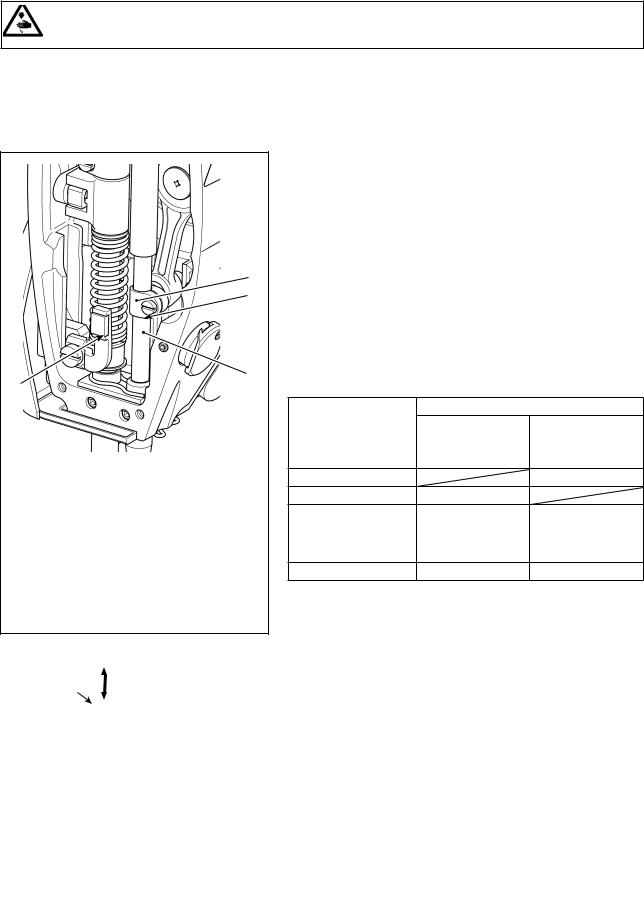
WARNING :
Turn OFF the power before starting the work so as to prevent accidents caused by abrupt start of the sewing machine.
3-6-3. Changing the initial value of presser foot pressure
If you want to change the initial value of presser foot pressure, it is possible to change the initial presser foot pressure by changing the mounting position of presser bar position bracket (upper) .
Carry out adjustment according to the sewing process as needed basis.
[How to adjust]
1)Turn OFF the power to the sewing machine.
2)Remove the face plate.
3)Loosen presser bar position bracket (upper) clamping screw . Adjust the vertical position of presser bar position bracket (upper) using marker line B on presser
bar as reference.
|
B |
* Adjust the orientation of presser bar position bracket |
|
|
|
||
|
|
(upper) so that it is in parallel with the face plate. |
|
|
|
4) After the completion of adjustment, tighten presser bar |
|
|
|
position bracket (upper) clamping screw and attach |
|
|
the face plate. |
||
|
Position of presser bar |
Presser foot pressure (Reference) |
|
position bracket (up- |
|
|
per) with respect |
S type |
H type |
to marker line B on |
||
presser bar |
|
|
4 mm above |
|
Approx. 0 N (0 kg) |
1 mm above |
Approx. 0 N (0 kg) |
|
0 (just beneath the |
|
|
marker line) |
Approx. 10 N (1 kg) |
Approx. 30 N (3 kg) |
(Factory-setting at the |
||
time of shipment) |
|
|
1 mm below |
Approx. 20 N (2 kg) |
Approx. 40 N (4 kg) |
|
3-6-4. Manual lifter |
|
|
The presser foot can be manually lifted/lowered by moving |
|
presser bar cap up and down while the power to the sew- |
||
|
||
|
ing machine is in the OFF state. |
|
|
Use this manual lifting feature when replacing the gauge or |
|
|
adjusting the needle entry area. |
|
|
|
– 22 –
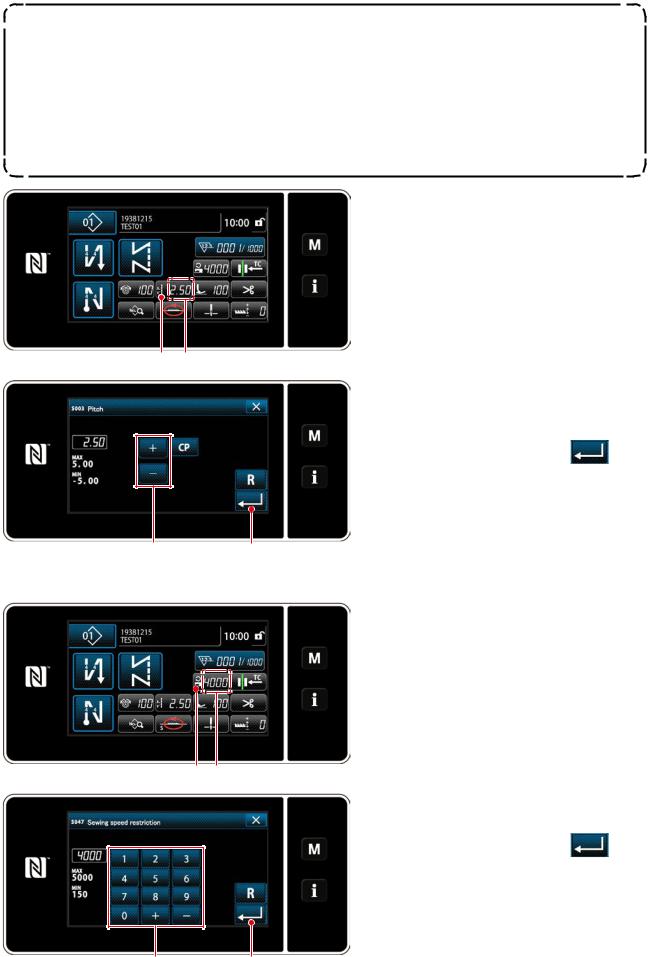
3-7. Adjusting the stitch length
1.There may be the cases where the feed amount of the operation panel and the actual sewing pitch are different from each other in case of the use in the state other than the standard delivery or material used. Compensate the pitch in accordance with the sewing product.
2.Be aware that interference between the throat plate and feed dog can occur depending on the gauge used. Be sure to check the clearance in the gauge to be used. (The clearance must be 0.5 mm or more.)
3.When you have changed the stitch length, feed dog height or feed timing, run the sewing machine at a low speed to make sure that the gauge does not interfere with the changed part.
Stitch length is displayed in section A on the panel. (Example of display : 2.50 mm)
[How to adjust]
1) Display the stitch pitch entry screen by pressing  .
.
A
2) The value displayed is changed by pressing  . (In increments of 0.05 mm ;
. (In increments of 0.05 mm ;
Input range : -5.00 to 5.00)
3) Confirm your entry by pressing |
. |
Then, the sewing screen is displayed. |
|
3-8. Changing the sewing speed
The sewing speed is displayed in section A on the panel. (Example of display : 4,000 sti/ min)
[How to change]
1) Display the sewing speed entry screen by pressing  .
.
A
2) Change the sewing speed as desired by pressing ten keys .
3) Confirm your entry by pressing |
. |
Then, the sewing screen is displayed. |
|
– 23 –
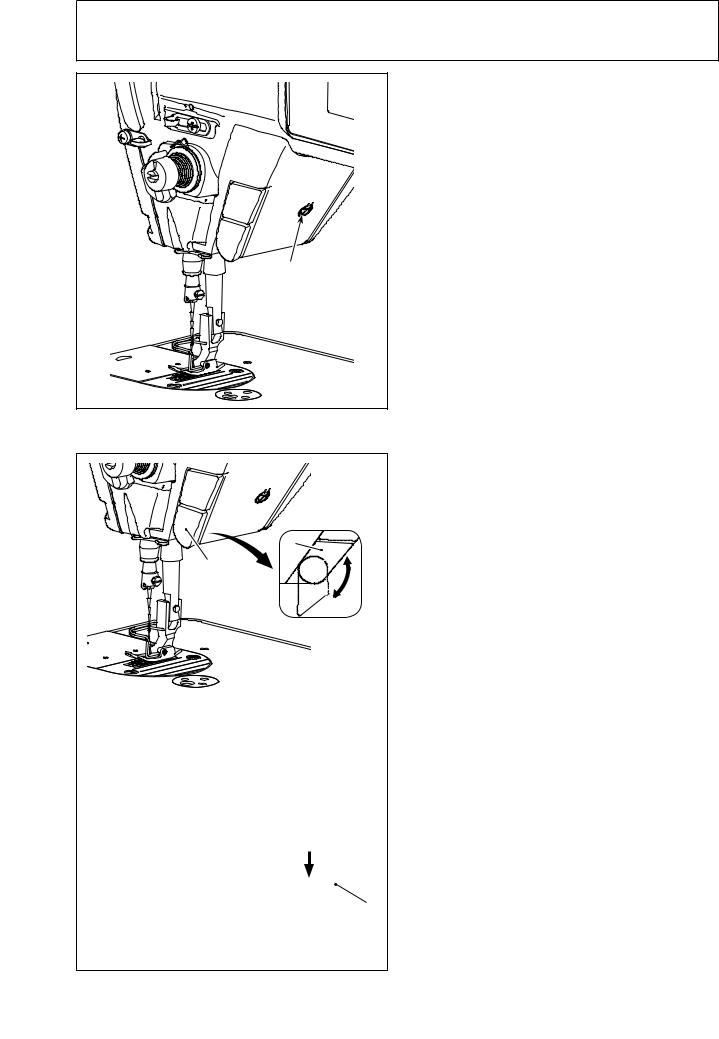
3-9. LED hand light
WARNING :
In order to protect against personal injury due to unexpected start of the sewing machine, never bring hands near the needle entry area or place foot on the pedal during the adjustment of intensity of the LED.
|
*This LED is intended to improve operability of the sewing machine and is not intended for maintenance.
The sewing machine is provided as standard with an LED light which illuminates the needle entry area. Intensity adjustment and turn-off of the light is carried out by pressing switch . Every time the switch is pressed, the light is adjusted in intensity in five steps and is turned off in turn.
[Change of intensity]
1 ...... 4 5 1 Bright ...... Dim Off Bright
In this way, every time the switch is pressed, the hand lamp status is changed in repetition.
3-10. Reverse feed stitching
|
Fig. 1 |
|
[One-touch type reverse feed stitching mechanism]
The one-touch type reverse feed switch is pressed, the machine performs reverse feed stitching.
The machine resumes normal feed stitching the moment the switch lever is released.
[Reverse feed stitching by means of the reverse feed lever]
Length of the seam sewn by feeding the material in the normal or reverse direction of feed can be controlled by operating reverse feed lever .
[Adjusting the position of one-touch type reverse feed switch]
One-touch type reverse feed switch can be used at two different positions by turning it. (Fig. 1)
– 24 –
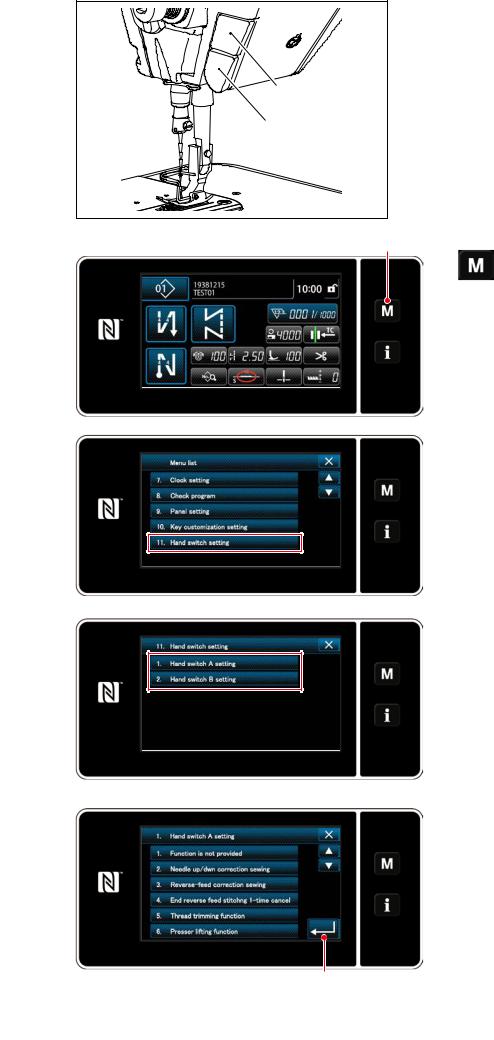
3-11. Custom switch |
|
|
|
|
|
Various operations can be carried out by operating |
|
|
|
custom switch B. |
|
|
|
* It is also possible to assign an operation to custom |
|
|
B |
switch A. |
|
|
The initial values are as follows: |
||
|
|
||
A |
|
Custom switch A : Input of reverse feed |
|
|
|
stitching switch |
|
|
|
|
|
|
|
Custom switch B : One-touch changeover |
|
|
|
|
switch |
|
|
|
held pressed for three second. |
|
|
1) |
|
|
|
|
The "mode screen" is displayed. |
2) Select the "11. Hand switch setting".
3) Select the switch to be set.
4) Select the function item which is to be assigned to the switch, and press  .
.
– 25 –
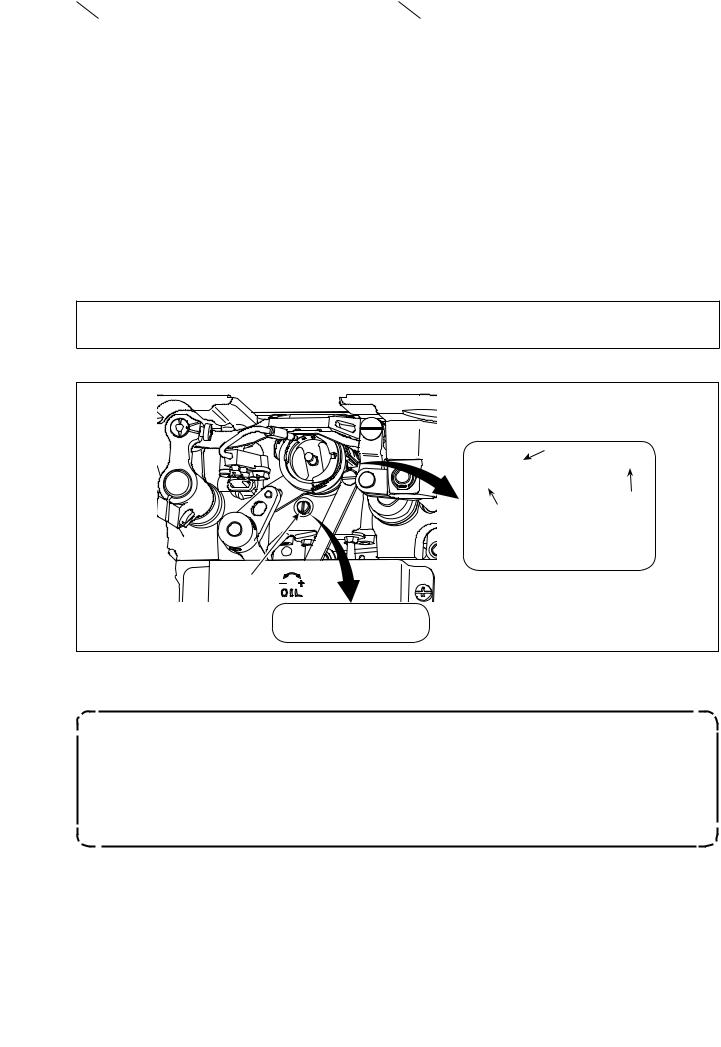
[Description of operations of the custom switch] |
|
|
|
|
|
|
|
|
|
|
Function item |
|
|
Function item |
1 |
Optional input function is not provided |
|
12 |
High speed command input |
2 |
Needle up / down compensating stitching |
|
13 |
Needle lifting function |
3 |
Back compensating stitching |
|
14 |
Reverse feed stitching switch input |
4 |
Function of canceling once reverse feed stitching at |
|
15 |
Soft start switch input |
|
the end of sewing |
|
16 |
One-shot speed command switch input |
5 |
Thread trimming function |
|
||
|
17 |
Backward one-shot speed command switch input |
||
6 |
Presser foot lifting function |
|
||
|
18 |
Safety switch input |
||
7 |
One stitch compensating stitching |
|
||
|
19 |
Automatic reverse feed stitching cancellation/addition |
||
8 |
Material edge sensor input |
|
|
switch |
9 |
Function of prohibiting depressing front part of pedal |
|
20 |
Sewing counter input |
10 |
Function of prohibiting thread trimming output |
|
21 |
One-touch type changeover switch |
11 |
Low speed command input |
|
|
|
3-12. Adjusting the amount of oil (oil splashes) in the hook
WARNING :
Be extremely careful about the operation of the machine since the amount of oil has to be checked by turning the hook at a high speed.
3-12-1. Adjusting the amount of oil in the hook
|
|
|
|
|
|
|
|
|
|
|
|
Decrease |
Increase |
|
Tighten (turn clockwise) oil amount adjustment screw to increase the amount of oil in the hook, or loosen (turn counterclockwise) to decrease it.
"When using RP hook (hook for dry head) for DDL-9000C-FMS type"
1.Remove hook driving shaft oil wick setscrew and attach hook driving shaft stopper screw(part number : 11079506) and rubber ring (part number : RO036080200).
2.Loosen oil amount adjustment screw up to the minimum so as to reduce the oil amount in
the hook. However, do not completely stop the oil and be careful not to allow oil adjustment screw to come off.
3.Never drain the oil in the oil tank even when RP hook (hook for dry head) is used.
– 26 –
